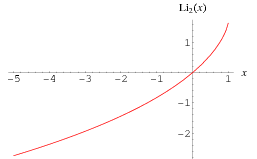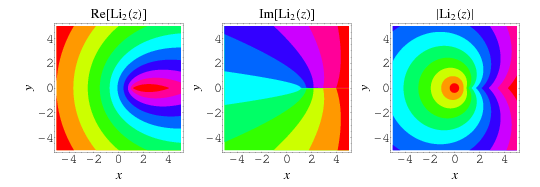

تاريخ الرياضيات

الاعداد و نظريتها

تاريخ التحليل

تار يخ الجبر

الهندسة و التبلوجي


الرياضيات في الحضارات المختلفة

العربية

اليونانية

البابلية

الصينية

المايا

المصرية

الهندية


الرياضيات المتقطعة

المنطق

اسس الرياضيات

فلسفة الرياضيات

مواضيع عامة في المنطق


الجبر

الجبر الخطي

الجبر المجرد

الجبر البولياني

مواضيع عامة في الجبر

الضبابية

نظرية المجموعات

نظرية الزمر

نظرية الحلقات والحقول

نظرية الاعداد

نظرية الفئات

حساب المتجهات

المتتاليات-المتسلسلات

المصفوفات و نظريتها

المثلثات


الهندسة

الهندسة المستوية

الهندسة غير المستوية

مواضيع عامة في الهندسة

التفاضل و التكامل


المعادلات التفاضلية و التكاملية

معادلات تفاضلية

معادلات تكاملية

مواضيع عامة في المعادلات


التحليل

التحليل العددي

التحليل العقدي

التحليل الدالي

مواضيع عامة في التحليل

التحليل الحقيقي

التبلوجيا

نظرية الالعاب

الاحتمالات و الاحصاء

نظرية التحكم

بحوث العمليات

نظرية الكم

الشفرات

الرياضيات التطبيقية

نظريات ومبرهنات


علماء الرياضيات

500AD

500-1499

1000to1499

1500to1599

1600to1649

1650to1699

1700to1749

1750to1779

1780to1799

1800to1819

1820to1829

1830to1839

1840to1849

1850to1859

1860to1864

1865to1869

1870to1874

1875to1879

1880to1884

1885to1889

1890to1894

1895to1899

1900to1904

1905to1909

1910to1914

1915to1919

1920to1924

1925to1929

1930to1939

1940to the present

علماء الرياضيات

الرياضيات في العلوم الاخرى

بحوث و اطاريح جامعية

هل تعلم

طرائق التدريس

الرياضيات العامة

نظرية البيان
Dilogarithm
المؤلف:
Abramowitz, M. and Stegun, I. A.
المصدر:
"Dilogarithm." §27.7 in Handbook of Mathematical Functions with Formulas, Graphs, and Mathematical Tables, 9th printing. New York: Dover
الجزء والصفحة:
...
9-8-2019
3288
Dilogarithm

The dilogarithm  is a special case of the polylogarithm
is a special case of the polylogarithm  for
for  . Note that the notation
. Note that the notation  is unfortunately similar to that for the logarithmic integral
is unfortunately similar to that for the logarithmic integral  . There are also two different commonly encountered normalizations for the
. There are also two different commonly encountered normalizations for the  function, both denoted
function, both denoted  , and one of which is known as the Rogers L-function.
, and one of which is known as the Rogers L-function.
The dilogarithm is implemented in the Wolfram Language as PolyLog[2, z].
The dilogarithm can be defined by the sum
 |
(1) |
or the integral
 |
(2) |


Plots of  in the complex plane are illustrated above.
in the complex plane are illustrated above.
The major functional equations for the dilogarithm are given by
 |
(3) |
 |
(4) |
 |
(5) |
 |
(6) |
 |
(7) |
A complete list of  which can be evaluated in closed form is given by
which can be evaluated in closed form is given by
 |
 |
 |
(8) |
 |
 |
 |
(9) |
 |
 |
 |
(10) |
 |
 |
 |
(11) |
 |
 |
 |
(12) |
 |
 |
 |
(13) |
 |
 |
 |
(14) |
 |
 |
 |
(15) |
 |
 |
 |
(16) |
 |
 |
 |
(17) |
 |
 |
 |
(18) |
 |
 |
 |
(19) |
where  is the golden ratio (Lewin 1981, Bailey et al. 1997; Borwein et al. 2001).
is the golden ratio (Lewin 1981, Bailey et al. 1997; Borwein et al. 2001).
There are several remarkable identities involving the dilogarithm function. Ramanujan gave the identities
 |
(20) |
 |
(21) |
 |
(22) |
 |
(23) |
 |
(24) |
 |
(25) |
 |
(26) |
(Berndt 1994, Gordon and McIntosh 1997) in addition to the identity for  , and Bailey et al. (1997) showed that
, and Bailey et al. (1997) showed that
 |
(27) |
Lewin (1991) gives 67 dilogarithm identities (known as "ladders"), and Bailey and Broadhurst (1999, 2001) found the amazing additional dilogarithm identity
 |
(28) |
where  is the largest positive root of the polynomial in Lehmer's Mahler measure problem and
is the largest positive root of the polynomial in Lehmer's Mahler measure problem and  is the Riemann zeta function.
is the Riemann zeta function.
REFERENCES:
Abramowitz, M. and Stegun, I. A. (Eds.). "Dilogarithm." §27.7 in Handbook of Mathematical Functions with Formulas, Graphs, and Mathematical Tables, 9th printing. New York: Dover, pp. 1004-1005, 1972.
Andrews, G. E.; Askey, R.; and Roy, R. Special Functions. Cambridge, England: Cambridge University Press, 1999.
Bailey, D. H.; Borwein, P. B.; and Plouffe, S. "On the Rapid Computation of Various Polylogarithmic Constants." Math. Comput. 66, 903-913, 1997.
Bailey, D. H. and Broadhurst, D. J. "A Seventeenth-Order Polylogarithm Ladder." 20 Jun 1999. http://arxiv.org/abs/math.CA/9906134.
Bailey, D. H. and Broadhurst, D. J. "Parallel Integer Relation Detection: Techniques and Applications." Math. Comput. 70, 1719-1736, 2001.
Berndt, B. C. Ramanujan's Notebooks, Part IV. New York: Springer-Verlag, pp. 323-326, 1994.
Borwein, J. M.; Bradley, D. M.; Broadhurst, D. J.; and Lisonek, P. "Special Values of Multidimensional Polylogarithms." Trans. Amer. Math. Soc. 353, 907-941, 2001.
Bytsko, A. G. "Fermionic Representations for Characters of  ,
,  ,
,  and
and  Minimal Models and Related Dilogarithm and Rogers-Ramanujan-Type Identities." J. Phys. A: Math. Gen. 32, 8045-8058, 1999.
Minimal Models and Related Dilogarithm and Rogers-Ramanujan-Type Identities." J. Phys. A: Math. Gen. 32, 8045-8058, 1999.
Erdélyi, A.; Magnus, W.; Oberhettinger, F.; and Tricomi, F. G. "Euler's Dilogarithm." §1.11.1 in Higher Transcendental Functions, Vol. 1. New York: Krieger, pp. 31-32, 1981.
Gordon, B. and McIntosh, R. J. "Algebraic Dilogarithm Identities." Ramanujan J. 1, 431-448, 1997.
Kirillov, A. N. "Dilogarithm Identities." Progr. Theor. Phys. Suppl. 118, 61-142, 1995.
Lewin, L. Dilogarithms and Associated Functions. London: Macdonald, 1958.
Lewin, L. Polylogarithms and Associated Functions. New York: North-Holland, 1981.
Lewin, L. "The Dilogarithm in Algebraic Fields." J. Austral. Math. Soc. Ser. A 33, 302-330, 1982.
Lewin, L. (Ed.). Structural Properties of Polylogarithms. Providence, RI: Amer. Math. Soc., 1991.
Nielsen, N. "Der Eulersche Dilogarithmus und seine Verallgemeinerungen." Nova Acta Leopoldina, Abh. der Kaiserlich Leopoldinisch-Carolinischen Deutschen Akad. der Naturforsch. 90, 121-212, 1909.
Watson, G. N. "A Note on Spence's Logarithmic Transcendent." Quart. J. Math. Oxford Ser. 8, 39-42, 1937.
 الاكثر قراءة في التفاضل و التكامل
الاكثر قراءة في التفاضل و التكامل
 اخر الاخبار
اخر الاخبار
اخبار العتبة العباسية المقدسة

الآخبار الصحية















 قسم الشؤون الفكرية يصدر كتاباً يوثق تاريخ السدانة في العتبة العباسية المقدسة
قسم الشؤون الفكرية يصدر كتاباً يوثق تاريخ السدانة في العتبة العباسية المقدسة "المهمة".. إصدار قصصي يوثّق القصص الفائزة في مسابقة فتوى الدفاع المقدسة للقصة القصيرة
"المهمة".. إصدار قصصي يوثّق القصص الفائزة في مسابقة فتوى الدفاع المقدسة للقصة القصيرة (نوافذ).. إصدار أدبي يوثق القصص الفائزة في مسابقة الإمام العسكري (عليه السلام)
(نوافذ).. إصدار أدبي يوثق القصص الفائزة في مسابقة الإمام العسكري (عليه السلام)


















